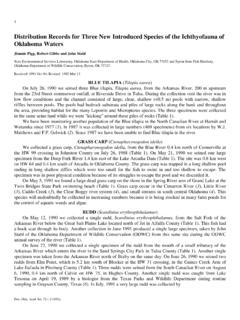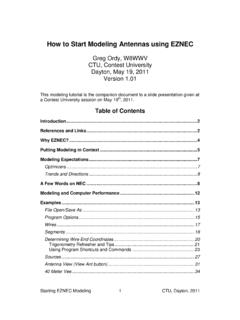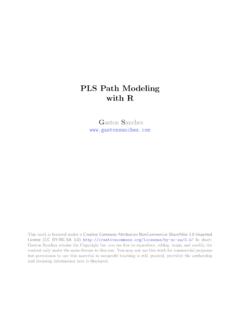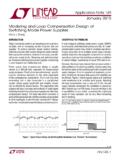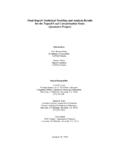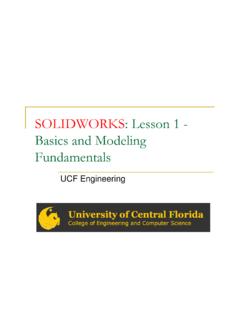Transcription of ANALYSIS, DESIGN AND MODELING OF DC-DC …
1 analysis , DESIGN AND MODELING . OF DC-DC converter using . simulink . By SAURABH KASAT. Bachelor of Engineering Institute of Engineering and Technology Indore, Madhya Pradesh State India Submitted to the Faculty of the Graduate College of the Oklahoma State University in partial fulfillment of the requirements for the Degree of MASTER OF SCIENCE. December, 2004. analysis , DESIGN AND MODELING OF DC-DC . converter using simulink . Thesis Approved: Dr. Chris Hutchens_____. Thesis Advisor _____Dr. Louis Johnson_____. _____Dr. Yumin Zhang_____. _____Dr. A. Gordon Emslie_____. Dean of the Graduate College ii Dedication To mummy and papa . iii ACKNOWLEDGEMENTS. Although it has just been just two and a half years studying in Oklahoma State University, it is an experience that will stay with me forever. My stay in Stillwater has given me a lot to cherish, good friendships, an excellent studying environment to name a few.
2 First of all I would like to thank my parents, Lalita Kasat and Bhagwandas Kasat. They have inspired me throughout my life and have taught me never to give up. I would also like to thank my sister and brother-in-law, Shradha Gattani and Ashish Gattani, for helping me realize my long standing dream of studying in an esteemed university. I. would also like to thank my Cousin, Amit Kasat for his help and support. I am thankful to all my colleagues in Mixed Signal VLSI (MSVLSI) lab for assisting and helping me on numerous occasions. I consider myself fortunate enough to have made a lot of good friends. I would like to thank all of them for the help and support they extended towards me. I would especially like to thank Amar, Samir and Dhagal for making my stay in Stillwater an experience of home away from home. iv I was fortunate enough to work under Dr.
3 Amanda Harrist at Human Development and Family Science. I would like to thank her for believing in me and providing me with financial support. I wish to extend my sincere appreciation to my adviser Dr. Chris Hutchens for his able guidance, intelligent supervision and inspiration that helped me finish this thesis. My sincere appreciation also extends to my committee members Dr. Yumin Zhang and Dr. Louis Johnson whose assistance and encouragement are also invaluable. Finally, I would like to thank the Department of Electrical and Computer Engineering for supporting me during these two and a half years of study. v TABLE OF CONTENTS. Chapter Page 1. Introduction and Thesis organization .. 1. Thesis Introduction .. 1. Background 3. Preliminary 3. Control bandwidth and transient 4. Thesis Organization .. 5. 2. Switched converter Topologies Overview.
4 6. 6. Buck converter .. 7. Synchronous rectification .. 8. Inductor Volt-Second 8. Capacitor charge balance .. 10. Boost converter .. 11. Buck-Boost converter .. 13. Cuk 14. Isolated DC-DC converter .. 15. Transformer 16. Flyback 16. 3. Buck 18. 18. Basic state space averaged model .. 19. State space averaged model of buck converter .. 21. Steady state 24. Small signal ac model .. 25. Component Selection .. 28. Inductor .. 28. Capacitor .. 28. Power mosfet selection .. 30. 4. Control Schemes and Compensation Techniques .. 32. 32. Basic control operation .. 33. Frequency response of buck converter .. 34. Voltage mode 36. vi PWM 36. Compensation of voltage mode loop .. 38. Current mode control .. 40. Current sensing techniques .. 40. PWM MODELING .. 41. Compensation current loop .. 44. V2 mode control .. 44. PWM 45. Compensation of V2 46. Comparison of three control 47.
5 5. simulink Implementation and DESIGN 50. 50. simulink models .. 51. Buck converter .. 51. OTA .. 52. Comparator .. 52. DESIGN Example .. 53. Voltage mode 54. Current mode control .. 55. V2 control .. 58. Transient response .. 58. V2 controlled .. 59. Voltage 61. Current controlled .. 62. 62. 6. Gate drive 64. 64. Gate drive basic operation .. 65. DESIGN considerations .. 66. 7. Conclusion and future work .. 69. Conclusion .. 69. Future 70. Appendix A - Gate Drive Circuitry .. 72. 72. Simulation 73. Appendix B simulink 75. Small signal 75. Voltage mode 75. V2 mode control .. 76. Current mode control .. 76. simulink OTA 77. vii Voltage mode model .. 78. V2 mode model .. 79. References .. 80. viii LIST OF TABLES. Table Page Comparison of control 48. ix LIST OF FIGURES. Figure Page : Buck converter .. 7. : Steady-state inductor voltage and current waveform, buck 9.
6 : Boost converter .. 11. : Steady-state inductor voltage and current waveform, boost 12. : Buck-boost 13. : Steady-state inductor voltage and current waveform, buck-boost 14. : Cuk 15. : Flyback converter .. 16. : Buck converter regulator system .. 19. : Buck converter ON 21. : Buck converter OFF state .. 23. : ac model of buck 26. : Block diagram of feedback 32. : Basic control principle .. 34. : Open loop 35. : PWM voltage mode 37. : Block diagram voltage mode 37. : Type II compensation .. 38. x : feedback loop response type II compensation .. 39. : Commonly used current sense 40. : PWM MODELING of current mode control with slope compensation .. 42. : Small signal model current mode control .. 43. : PWM MODELING V2 control .. 45. : Small signal model V2 control .. 46. : V2 Compensation .. 47. : simulink model of buck 51. : simulink model of OTA.
7 52. : simulink model of comparator .. 53. : Open loop buck converter 54. : Open loop voltage mode compensated transfer 55. : Current loop bode plot current mode 56. : Control to output bode plot - current mode control .. 57. : Compensated control to output loop and 58. : Open loop V2 mode compensated transfer function .. 59. : V2 response to load variations .. 60. : V2 response to line variations .. 60. : Volt-Seconds characteristics of 65. : Gate drive using pulse 65. : Bench prototype of gate drive circuitry .. 72. : Voltage mode small signal block diagram .. 76. : V2 control small signal block diagram .. 76. xi : OTA with feedback and feedback sub-block .. 78. : Full simulink model of voltage mode control .. 78. : Full simulink model of V2 mode 79. xii Glossary Upper case variables refer to steady state DC conditions. Lower case symbol with a caret on top is the small signal perturbation around steady state.
8 D Duty cycle d' Complement of duty cycle 1-d fsw Switching frequency FM Modulation gain of duty cycle Gc(s) Compensation network Gd(s) Output voltage to duty cycle transfer function Gi(s) Inductor current to duty cycle transfer function Gvg(s) Output voltage to input voltage transfer function iL Inductor current iC Capacitor current Q Q of double pole due to LC filter section in buck converter R Output load Rc Capacitor equivalent series resistance RL Inductor series resistance Ron Transistor ON resistance vL Voltage across inductor vg Input line voltage xiii vo Output load voltage vc Compensator output voltage Tc(s) Current control loop transfer function Ti(s) Current control current loop transfer function Ton Switch on time Toff Switch off time Tsw Switching period Tv(s) Voltage control loop transfer function Tv2(s) V2 control loop transfer function xiv Chapter 1.
9 Introduction and Thesis organization Thesis Introduction Every Electronic circuit is assumed to operate off some supply voltage which is usually assumed to be constant. A voltage regulator is a power electronic circuit that maintains a constant output voltage irrespective of change in load current or line voltage. Many different types of voltage regulators with a variety of control schemes are used. With the increase in circuit complexity and improved technology a more severe requirement for accurate and fast regulation is desired. This has led to need for newer and more reliable DESIGN of DC-DC converters. The DC-DC converter inputs an unregulated dc voltage input and outputs a constant or regulated voltage. The regulators can be mainly classified into linear and switching regulators. All regulators have a power transfer stage and a control circuitry to sense the output voltage and adjust the power transfer stage to maintain the constant output voltage.
10 Since a feedback loop is necessary to maintain regulation, some type of compensation is required to maintain loop stability. Compensation techniques vary for different control 1. schemes and a small signal analysis of system is necessary to DESIGN a stable compensation circuit. State space analysis is typically used to develop a small signal model of a converter and then depending on the type of control scheme used, the small signal model of converter is modified to facilitate the DESIGN of the compensation network. In contrast to a state space approach, PWM switch MODELING develops a small signal of switching components of converter [4]. Behavioral MODELING of the IC system represents the functionality of an IC with macro models rather than actual implementation of the circuit using more efficient MODELING techniques. Matlab simulink and Verilog-A are powerful tools to develop behavioral models of electronic system.


